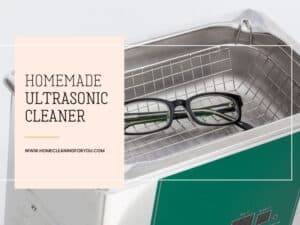11 Powerful DIY Tile and Grout Cleaners to Make
Have you ever thought about why you need to make a homemade tile and grout cleaner? Why bother doing it when you can buy it in the first place, or why the need to clean the grout between tiles on the floors, countertops, and shower walls?
The reason is as much as you think your home is cleaning, especially since you’ve done your due diligence in cleaning them on a regular basis, the grout between tiles will inevitably get dirty, thus defeating the whole purpose of cleaning tiles and other areas of the house.
Before spending a fortune on toxic commercial cleaners in the hope of turning the situation around, let’s explore in-depth how you can make your own cleaner that is way much less expensive and toxic by using one of the 11 highly recommended DIY recipes below.

11 Highly Effective DIY Tile And Grout Cleaner Recipes
So your tiles and grout are filled with discoloration, dirt buildups, stains, and ugly hues, and you’re struggling with how to best remove these unsightly messes. Stay tuned because I will walk you through step-by-step instructions on how to them using home ingredients.
1. Essential Homemade Tile And Grout Cleaner (Using Baking Soda And Hydrogen Peroxide)

This recipe is the best tile and grout cleaner, and I always resort to it whenever I need a good daily cleaner for my tiles and grout. It’s super effective and oh-so-easy to make. All you need to do is follow the instructions right below.
How to make and use it:
- Step 1 – Take a small, squeeze-top container (you can use a liquid soap bottle) and use a funnel to pour ½ cup of baking soda and ¼ cup of hydrogen peroxide.
- Step 2 – Add 1 teaspoon of liquid dish soap into the mixture and shake well to combine all the ingredients together.
- Step 3 – Squeeze the mixture onto the grout and tiles, and leave for 5 minutes or more.
- Step 4 – Use a sponge to scrub off the dirt, soap scum, or other residues. Rinse off fully with water and use a clean cloth to dry the surface.
Using baking soda and hydrogen peroxide for a fantastic DIYgrout cleaner.
2. Classic Homemade Tile And Grout Cleaner (Using Vinegar And Baking Soda)

If you’re a DIY type of person, especially when it comes to cleaning your house, you must have stumbled on various cleaning recipes that use the classic combo of vinegar and baking soda for different types of materials, stains, and surfaces.
Well, using it on your tile and grout is no exception. Let’s look at a few easy steps down here to know how to use it correctly on your floor (and grout!).
How to make and use it:
- Step 1 – Create a paste of baking soda and white vinegar so that it’s not too thick and not too thin.
- Step 2 – Apply all over the tiles and the grout in between, and let it sit for approximately 10 minutes.
- Step 3 – Use a soft sponge to clean the tile and a stiff-bristled brush/old toothbrush to scrub the grout.
- Step 4 – Rinse the whole area with warm water till clean.
Grab your baking soda and vinegar, and get ready to clean your tile grout.
3. No-Fuss DIY Tiles And Grout Cleaner (Using Lemon Juice)

Thanks to the mild level of acidity that exists in lemons, using lemon juice is a way to remove various mild stains and soap scum build-ups on your tiles and grout. It is non-toxic, all-natural and the best part is, it doesn’t etch or damage the surface of the tiles floors.
Follow this recipe to learn how to make this wonderful cleaner at home.
How to make and use it:
- Step 1 – Create a paste by combining 3 tablespoons for each ingredient – lemon juice and baking soda in a small bowl (apply ½ tablespoon of baking soda at a time to create a slightly thinner consistency compared to toothpaste).
- Step 2 – Use an old toothbrush (or your fingers if you don’t have one) and apply the paste onto the grout. Leave it for a minimum of 5 minutes.
- Step 3 – Use a soft brush or a cloth to rub off all unwanted buildups on the tiles and grout. Rinse off with warm water and repeat these steps if necessary.
4. Must-Have Homemade Tile And Grout Cleaner (Using Castile Soap And Essential Oils)

I like cleaners that are efficient at doing their jobs whilst leaving your home smelling amazing. And the perfect combination of baking soda, castile soap, and essential oils will do the job and deliver results beyond expectations. Let’s start.
How to make and use it:
- Step 1 – In a glass container, pour ½ cup of baking soda, 3 tablespoons of liquid castile soap, and 20-25 drops of essential oils (I always go for the combination of lavender, tea tree, and lemon). Use a scraper to whisk all the ingredients together.
- Step 2 – Apply the paste generously on the wanted areas by using an old toothbrush/scrub brush. Leave it for a while.
- Step 3 – Use the same brush to scrub the tiles and grout.
- Step 4 – Scrub the same areas thoroughly with a wet brush. By doing this step, the mixture will foam up and lift the dirt and buildups with it.
- Step 5 – Rinse off with water and dry the areas with a clean cloth.
5. Powerful Heavy-Duty Tile And Grout Cleaner (Using Ammonia)

A well lived-in house is a perfect house for everyone who lives in it, but not so much for the floors that are laid underneath. Daily activities of cooking, playing, and using can take a beat on the house, especially the tiles and grout underneath.
By making and using this cleaning method periodically, your house will become spotless and completely stain-free.
How to make and use it:
- Step 1 – Using a gallon container, mix ⅓ cup of ammonia, ½ cup of baking soda, ¼ cup of white vinegar, and 7 cups of warm water. Stir till fully blended.
- Step 2 – Transfer the solution into a glass spray bottle, then spray the solution directly on the stains, grout lines, and tile floors. Leave the whole area for several minutes.
- Step 3 – Use a light scrub brush to take off the stains and dirt. Wipe the tiles with a soft sponge or a cloth.
- Step 4 – Wipe the grout lines with a damp cloth to avoid the residue sticking back to the lines. Rinse and let the floor dry.
6. Natural Tile And Grout Target Whitener (Using Cream Of Tartar And Lemon Juice)

This is by far one of my favorite tile and grout target whiteners since the lemon juice, when combined with cream of tartar, reacts so well that makes the pair the perfect all-natural grout whitener. It also works well on certain surface stains too.
How to make and use it:
- Step 1 – Take a small bowl and squeeze in a good amount of lemon juice with 2 teaspoons of cream of tartar. Mix the ingredients till the whole thing becomes a “runny toothpaste” consistency.
- Step 2 – Apply the solution onto the grout and scrub well using a scrub brush/toothbrush on targeted areas (pay attention to little nooks and crannies and dull/blackened areas).
- Step 3 – Rinse well and wipe dry.
7. Single-Ingredient Tile and Grout Whitener (Using Hydrogen Peroxide)

This method is perfect if you have some hydrogen peroxide at home and can’t be bothered to do all the mixing and whisking but still want the maximum results for your tiles and grout to become sparkly white again. It’s easy and will literally take less than a few minutes to do.
How to make and use it:
- Step 1 – Pour some hydrogen peroxide into a spray bottle and spray liberally on the grout.
- Step 2 – Take an old toothbrush/scrub brush to clean off the soil and dirt on the grout.
- Step 3 – Rinse with water and let it dry.
8. The Most Effective Tile And Grout Whitener (Using Oxygen Whitener)
I am all for all-natural cleaners, but sometimes just those ingredients are not enough to fully sweep the stains and dirty buildups on the grout. That’s why I love using Oxygen Whitener (it’s a truly safe alternative for bleach to whiten clothes and hard surfaces).
This method also works wonders on yellow/orange tiles and grout. To know how to integrate this ingredient into your homemade tile and grout cleaner, follow the instructions below.
How to make and use it:
- Step 1 – use a container to mix some Oxygen Whitener with a bit of water to create a paste. I also like to add a few drops of liquid castile soap to enhance the cleaning power (but it’s totally optional).
- Step 2 – Wet the tile. Apply the paste onto the grout and scrub away.
- Step 3 – Rinse and wipe dry.
9. Top Homemade Cleaner For Old Tile And Grout (Using Borax)

Another gem for tile and grout cleaning ingredients is Borax. I find this method works best on old tile floors, and it can almost restore your tile floor and grout back to the original condition, especially after you use this method a few times. Let’s see how.
How to make and use it:
- Step 1 – Take out a container and place ½ cup of baking soda, ⅓ cup of Borax, and slowly pour some hot water till it forms a nice paste.
- Step 2 – Apply a thin layer of the paste onto the tile and a thicker layer on the grout. Let it sit for a few minutes.
- Step 3 – Use a scrub/toothbrush to effectively lift off the dirt that comes up on the surface. (If the cleaning area is quite large, then I recommend creating a new batch of the paste since you’ve dipped the dirty brush in it many times).
- Step 4 – Rinse and wipe thoroughly.
Note: If the paste hardens after a while, just pour a bit more hot water into the paste and whip it up. It should be fine by then.
Cleaning tile and grout with borax should not be overly complicated.
10. Organic Tile And Grout Mildew Remover/Scrub (Using Salt)

I like to resort to salt for cleaning whenever I can. Not only is it super cheap to buy, but it is also widely known for its antibacterial properties (1). It can also remove molds and mildew growing on the tile and grout in just a minute (2).
How to use it:
- Step 1 – Wet the wanted areas or run a damp cloth over them (you need to use this method on wet surfaces)
- Step 2 – Sprinkle the salt in a generous amount on the affected areas.
- Step 3 – Leave it overnight (8-12 hours). Scrub and rinse it in the morning (The molds and mildew will be completely gone!)
11. Easy DIY Tile And Grout Disinfectant (With Rubbing Alcohol)

To maintain a pristine surface for your tile and grout, I highly recommend disinfecting it on a regular basis. This method kills and removes germs, bacteria, viruses and prevents mildews from building up on the surface, using the truly number 1 disinfectant – rubbing alcohol.
How to make and use it:
- Step 1 – Dilute equal parts of rubbing alcohol and water in a small spray bottle.
- Step 2 – Spray directly onto the tiles and the grout. Leave it for 10 minutes.
- Step 3 – Wipe away with a dry cloth (No rinse needed).
FAQs
Cleanliness Is Next To Godliness
Keeping your home tidy is important, but it’s just as important that you pay attention to what might seem to be minuscule details, such as performing a regular cleaning routine for your tiles and grout so that the entire space is always fresh and clean.
If you have any questions, tips, and tricks that you would like to share, feel free to drop them down in the comment section. I am looking forward to hearing from you all, and stay tuned for more creative DIY recipes in the coming weeks. Enjoy cleaning!

References
- Davies, E., 2021. Why does salt have antibacterial properties?.
- Hunker. 2021. Does Salt Kill Mold?.







Samantha Lee
Head Cleaning Expert
Expertise
Professional Home Cleaning, Green Cleaning Techniques, Stain Removal & Fabric Care, DIY Home Maintenance & Organization, Sustainable Cleaning Products, Home Care for Busy Lifestyles
Education
University of Denver
Samantha Lee is the Head Cleaning Expert at HomeCleaningForYou.com, specializing in eco-friendly home care. She holds a Bachelor of Science in Environmental Science from the University of Denver, focusing on sustainable cleaning solutions.
With expertise in green cleaning, stain removal, and DIY home maintenance, she helps homeowners keep their spaces fresh and chemical-free. Samantha has been featured in lifestyle publications and has partnered with brands promoting natural cleaning products.
She also shares practical tips through her blog, online courses, and workshops. Passionate about sustainability, she enjoys testing new eco-friendly cleaning methods and spending time outdoors.